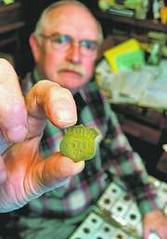
PREV ARTICLE
NEXT ARTICLE
FULL ISSUE
PREV FULL ISSUE
ARTICLE HIGHLIGHTS ROBERT LEE BURTON'S EASTERN SHORE PICKING AND CANNERY TOKENS This article from Bethany Beach, DE puts a spotlight on token collecting and research. -Editor  What started out as a hobby became a mission, as the late Robert Lee Burton of Cambridge discovered when he sought out tokens -- those paper, metal, rubber, fiber and even leather substitutes for money used by Shore farmers and canning houses decades ago. What started out as a hobby became a mission, as the late Robert Lee Burton of Cambridge discovered when he sought out tokens -- those paper, metal, rubber, fiber and even leather substitutes for money used by Shore farmers and canning houses decades ago. For years, the former state employee traveled the Shore digging his way through antique shops, barns, sheds, buckets -- and even sifting through dirt -- looking for examples of lost or forgotten tokens. They came in a variety of sizes and styles -- circular, square and badge-shaped, diamonds and multi-sided and were given to workers for picking strawberry, peaches, tomatoes and for skinning tomatoes, shucking oysters and picking crabs. At the end of the day or week, a worker redeemed tokens for cash or even credit at the company store. Introduced in the 1860s, their use had vanished by the 1950s. That hobby came about while Burton was working on a book on area canneries. "There was over a thousand different canneries that operated on the Eastern Shore, with 246 operating at one time," said George Chevalier, president of the Wicomico County Historical Society and a founder of the Maryland Token and Medal Society in 1976. Through the society, he met Burton. "While Mr. Burton was interviewing the families who owned and operated these canning factories for his book, which he started in 1981, and a lot of them showed him tokens and many were given to him." Burton authored "Canneries of the Eastern Shore," the Bible of token collecting published in a limited edition in 1986. It is already considered a rare Maryland book and is itself collected by the token collectors. "There were only 1,500 printed, but there was a fire and 300 were destroyed at the printers in Centerville," Chevallier said. Burton, who had a reputation among collectors for being tight fisted, never paid more than $40 for a token, his friend said. "But above all, he was the dean of token collectors," Chevallier said. To read the complete article, see Tokens hold a piece of history (http://www.delmarvanow.com/article/20090111/LIFESTYLE/901110320) Wayne Homren, Editor The Numismatic Bibliomania Society is a non-profit organization promoting numismatic literature. See our web site at coinbooks.org. To submit items for publication in The E-Sylum, write to the Editor at this address: whomren@gmail.com To subscribe go to: https://my.binhost.com/lists/listinfo/esylum All Rights Reserved. NBS Home Page Contact the NBS webmaster 
|